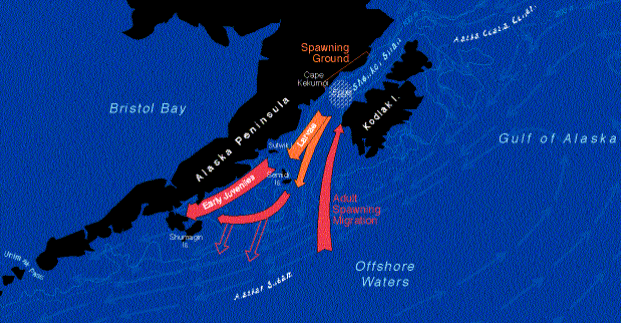 Shelikof
Strait studies provide a good example. The research domain extends
from the Kenai Peninsula (not shown) southwest to the Shumagin Islands.
Because the reproductive strategy of pollock is to produce millions of
progeny, only a few of which survive to be adults, the focus is on the
early life stages of pollock and those environmental processes that affect
them. Pollock return to spawn (red, north-pointing arrow) at the
same region of the strait during a few weeks in the spring of each year.
Eggs (stipled area) are laid deep in the water column and hatch after about
two weeks. Larvae rise to the mixed layer and are transported southwestward
(orange arrow) by the Alaska Coastal Current. Some are transported
out the sea valley to the nutrient-depleted Alaskan Stream where they are
thought to perish. Others remain on the shelf in adequate nursery
waters and develop into juveniles (pink arrows). To study the fish
and environment, FOCI has established long-term time series and conducts
studies of biophysical processes. Shelikof
Strait studies provide a good example. The research domain extends
from the Kenai Peninsula (not shown) southwest to the Shumagin Islands.
Because the reproductive strategy of pollock is to produce millions of
progeny, only a few of which survive to be adults, the focus is on the
early life stages of pollock and those environmental processes that affect
them. Pollock return to spawn (red, north-pointing arrow) at the
same region of the strait during a few weeks in the spring of each year.
Eggs (stipled area) are laid deep in the water column and hatch after about
two weeks. Larvae rise to the mixed layer and are transported southwestward
(orange arrow) by the Alaska Coastal Current. Some are transported
out the sea valley to the nutrient-depleted Alaskan Stream where they are
thought to perish. Others remain on the shelf in adequate nursery
waters and develop into juveniles (pink arrows). To study the fish
and environment, FOCI has established long-term time series and conducts
studies of biophysical processes. |